Crankbait Fishing For Salmon: Most Effective Guide Methods
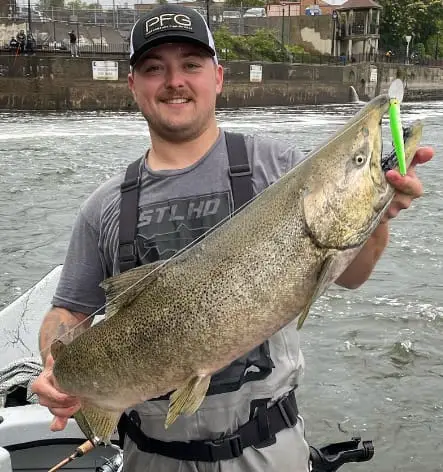
Crankbait fishing for salmon has gained widespread popularity among anglers targeting salmon. Crankbaits are one of my favorite salmon lures, and for good reason.
Skilled fishermen and guides who specialize in crankbait fishing consistently achieve impressive results when fishing salmon in rivers, from piers and shorelines, and from boats.
When I am guiding for salmon with crankbaits, these are the things I ensure my clients learn:
- The Best Lures – Which lures are best based on the conditions
- The Best Colors – I change colors based on the water clarity and how the salmon react.
- The Best Sizes – I change sizes based on the conditions and salmon preference.
- Depth – How to determine the depth you should be fishing
- Effective Coverage – How to cover the water effectively
- Presentation – Proper presentation for different water conditions.
- Lure Action – How to increase the effectiveness of your crankbait to trigger more bites.
Choosing the Right Crankbaits for Salmon Fishing
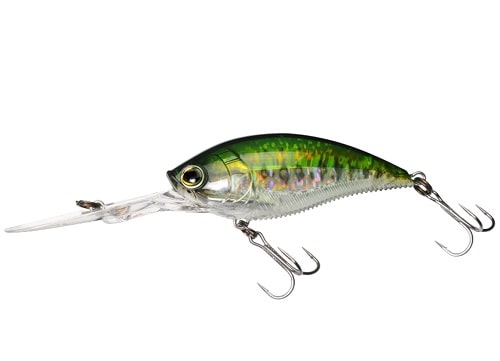
I only use good quality crankbaits of appropriate sizes and colors because I know that big salmon are not only picky when it comes to size and color but they can destroy cheap crankbaits with cheap hooks.
I’ve also seen salmon snap rods, so make sure you’ve got a good salmon rod for lure fishing. Check out 11 Best Salmon Rods.
If you want to land your salmon, make sure the crankbait you use is up to the job. I’ll discuss some of my favorite crankbaits below.
Are Crankbaits Good For Salmon?
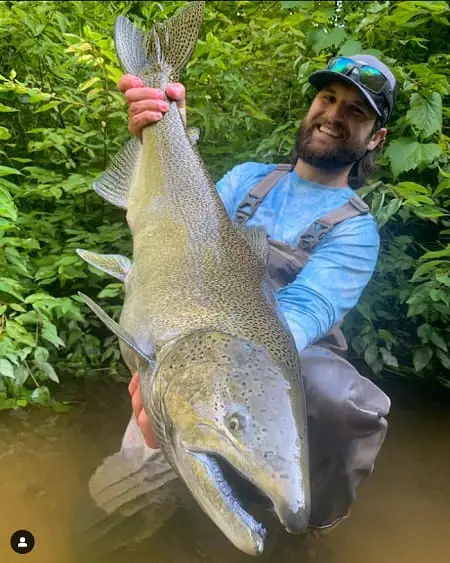
This is a question I’ve been asked before, and the answer is that crankbaits are highly effective lures when targeting salmon in rivers and nearshore areas.
At times, crankbaits will outperform bait and other lures.
Salmon display aggressive behavior and will strike at anything smaller than them that enters their territory. Because of this, even salmon that have gone off the feed can still hit a well-presented crankbait that resembles baitfish and exhibits erratic movements.
This is why so many anglers and fishing guides across the United States and Canada use crankbaits to target salmon.
Even anglers who are less experienced in crankbait fishing can still have a good chance of catching salmon.
When guiding for salmon using crankbaits, my approach varies depending on several factors, such as river conditions, depth, water clarity, current speed, and the activity level of the salmon. Choosing the most suitable crankbait based on these conditions is crucial.
Crankbaits offer the advantage of covering a large area of water quickly, as well as targeting multiple depths.
Exploring the Basics of Crankbait Fishing for Salmon
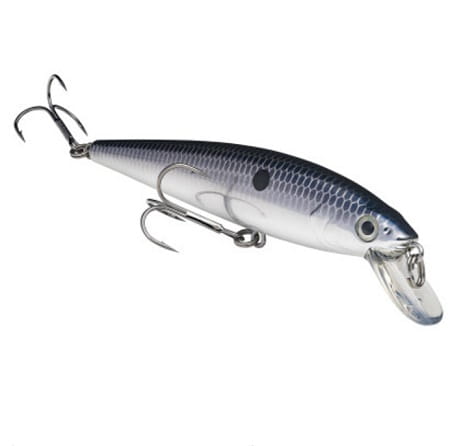
Crankbait fishing involves using a lure known as a crankbait, which resembles the shape of a minnow and typically features 2 to 3 treble hooks.
Few lures can match the action and vibration produced by crankbaits, which contributes to their effectiveness.
The lifelike movement and resemblance to baitfish can attract salmon from considerable distances, while the flash of the crankbait triggers strikes when it approaches the salmon.
However, not all crankbaits are equally suitable for salmon fishing, especially current. Through experience, I have found that some crankbaits perform better than others. It is crucial to select crankbaits of appropriate size, color, and weight.
I also only use high-quality crankbaits that can withstand the battle of a large salmon since I know that cheap crankbaits break or the hooks bend.
Outlined below are recommended crankbaits for salmon fishing, each possessing captivating flash, action, and vibration that imitate distressed fish. These crankbaits cast well, and they perform well in currents.
Best Crankbaits for Salmon Fishing
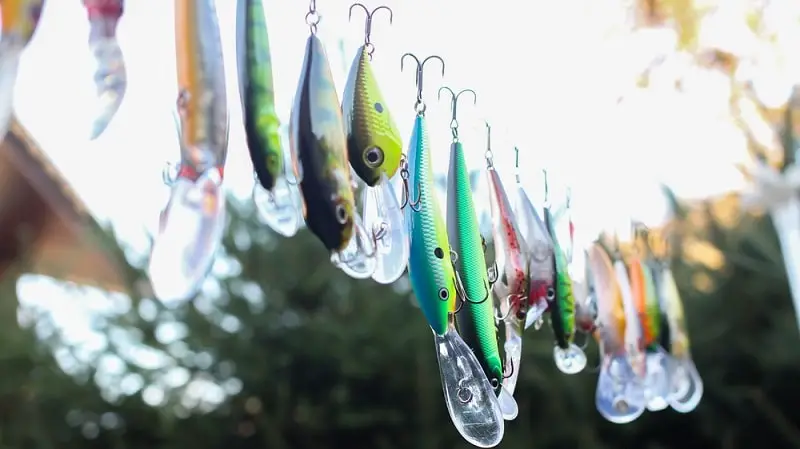
When selecting crankbaits, consider the following types:
Slender Body Crankbaits: Designed for faster and deeper retrieves, these crankbaits excel in slower currents and deeper water. They come in straight models, jointed models, and they usually have a good wobble and action.
Fat Body Crankbaits: Fat-bodied crankbaits have a tight wobbling action, they also effectively displace larger volumes of water. The fat body crankbaits come in shallow lip and deep lip options but I usually prefer a deep or mid-deep lip. These are great in all water depths and are usually the best in faster currents.
Deep Lip Crankbaits: I often prefer using deep lip or medium deep lip crankbaits, particularly in rivers. The deep lip helps maintain the crankbait’s depth even during an ultra-slow retrieve or in fast currents. These crankbaits can reach depths of over 20 feet, but it requires sufficient line out to get maximum depths.
Shallow Lip Crankbaits: Shallow lip crankbaits, also known as shallow-running crankbaits, are suitable for both rivers and lakes. However, they are more commonly used by lake anglers.
Some shallow lip crankbaits can work well in rivers with slow to medium-speed currents, while some do not work. It’s important to note that certain shallow lip crankbaits may not perform effectively in faster currents as they tend to pop out of the water. Generally, shallow lip crankbaits can reach depths of 2 to 5 feet.
Rattle Crankbaits: Some crankbaits come equipped with built-in rattles. In my experience, the additional noise produced by the rattle tends to attract and catch more salmon. Rattle crankbaits are my most effective crankbait in faster and higher water, and in murky or stained water, and during night fishing for salmon.
Non-Rattle Crankbaits: Non-rattle crankbaits produce less sound and vibration sound. However, it’s important to note that they still emit noise below the water’s surface, which can be detected by salmon. The sound is created by the hooks bumping against the body of the crankbait.
In underwater tests, we observed that a ticking-type noise was audible from a distance of about 5 feet. Considering the sensitive lateral line of salmon, it’s likely they can hear the crankbait from even further away.
When selecting crankbaits, refer to the information provided on the packaging regarding their running depth range. It’s wise to have a variety of crankbaits of different depths on hand to ensure you can effectively cover all water depths when necessary. I’ll discuss water depths below.
GUIDE TIP: You can adjust the running depth of deep-diving crankbaits by elevating your rod tip or submerging it while reeling in. This technique is particularly useful for shallow lip crankbaits.
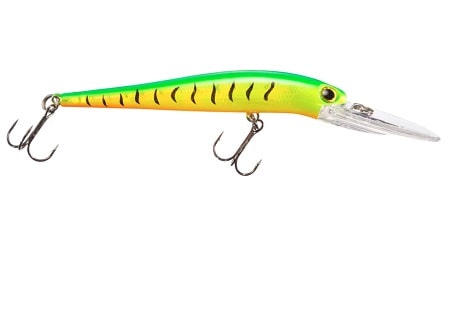
Many guides including Kelly from Northern Michigan Custom Rod and Guide Service says the “Thunderstick is top crankbait for Kings”.
He also likes the deep diving models and based on his pictures he prefers the Chartreuse or brighter colors like the Luminous Green Herringbone.
Some of the best crankbaits for salmon are the Strike King KVD, Rapala J13, Rapala Tail Dancer.
Check my most effective crankbaits and other good salmon lures.
Determining The Ideal Length of Crankbaits for Salmon Fishing
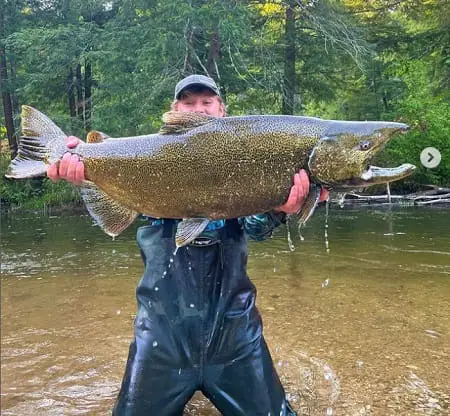
The optimal length of crankbaits for salmon typically ranges from 3 to 6 inches.
For me, the go-to size is usually 4.5 – 5 inches, as it closely matches the size of most baitfish found in rivers or the ones salmon typically feed on in the ocean.
A length of 5 inches is generally ideal for targeting larger salmon in various water conditions. It provides a substantial target that captures the attention of salmon.
As a general rule, use larger crankbaits in turbid or high-flow conditions and when fishing in dirtier water. In contrast, opt for smaller crankbaits in very clear water or when targeting cautious fish holding in pools.
Choosing the Best Colors for Crankbaits When Targeting Salmon
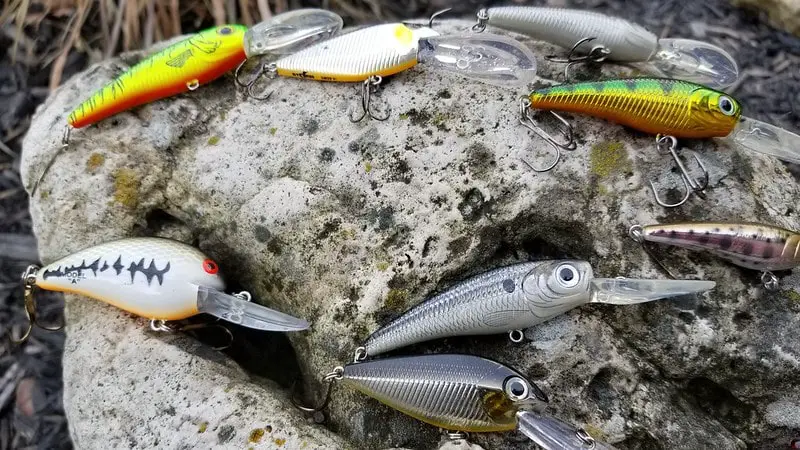
The color of the crankbait plays a significant role in attracting the interest of salmon and enticing them to strike. However, the most effective color depends on the mood of the salmon and the prevailing water clarity and light conditions.
Silver, gold, or brightly colored crankbaits with reflective surfaces tend to be highly effective. The flash they create can be spotted by salmon from a considerable distance.
Under specific conditions, I have had great success with black crankbaits or black/silver combinations.
Based on my experience, the most consistent and reliable colors for salmon fishing in rivers include chartreuse, chartreuse/silver, silver, silver/orange, green/silver, and blue/silver.
Effective Techniques for Crankbait Fishing
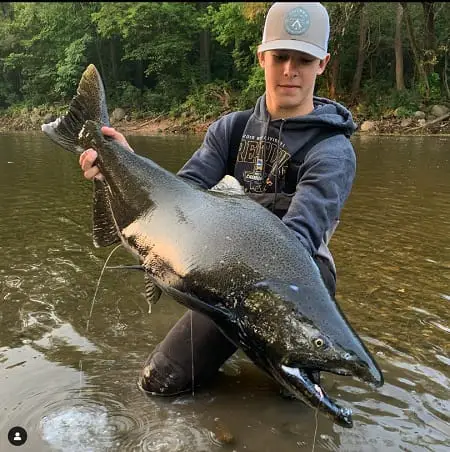
When targeting salmon with crankbaits, three techniques have proven to be highly effective:
Method #1: The most commonly used technique involves casting the crankbait into the river and retrieving it with a slow and steady motion.
Depending on the depth and speed of the river, you may need to let the crankbait sink for a moment or adjust its depth accordingly.
Later, we will delve into depth and water column coverage in more detail.
Method #2: To enhance the effectiveness of the straight retrieve method, I recommend incorporating ripping or twitching actions into your retrieve. Every 5 feet or so, give the crankbait a sharp jerk or twitch to simulate the movement of an injured or dying baitfish. This erratic retrieve often doubles the number of salmon strikes.
Method #3: This technique works best in faster currents. Begin by casting the crankbait across and slightly downstream, allowing the current to carry the lure across the pool without reeling. This “swing” technique mimics the natural movement of a baitfish as it sinks, wobbles, and entices salmon to strike. You can further enhance this method by incorporating ripping, twitching, and pausing actions, which can be highly effective.
How Fast Should You Reel In A Crankbait For Salmon?
The retrieval speed of your crankbait depends on several factors, including the lure’s action, your reel speed, and the velocity of the current. I recommend retrieving the crankbait at a speed that allows salmon to detect it, see it clearly, and strike at it. Generally, a slow to medium retrieval speed is effective.
However, there are instances when you can reel in the crankbait faster to cover more water, especially if you are targeting aggressive salmon that are actively pursuing prey.
If you notice that the crankbait is consistently popping out of the water’s surface, it indicates that you are reeling too fast or holding your rod tip too high. Try to maintain a steady retrieval speed that allows the lure to have good action, watch the lure as it comes in close to you and adjust faster or slower as required.
If the current in the middle of the river is faster, you should slow down your reeling speed to match its pace, otherwise it could blow out. The current itself will provide action and movement to the crankbait even without continuous reeling.
In very swift currents, you may not need to reel at all, and you can simply allow the lure to swing across the river.
It’s worth noting that when using shallow lip crankbaits and some deep lip crankbaits, the faster you reel, the higher the crankbait will remain in the water column. This may not be ideal for enticing salmon that are holding deeper and are less likely to rise up for a lure.
Determining the Optimal Depth for Crankbait Fishing
Although salmon are often found near the riverbed, it doesn’t necessarily mean that your crankbait should be at the same depth. To determine the ideal depth for your crankbait, aim to position it approximately 2 to 3 feet above the salmon’s heads.
In clear water, you might be able to get away with just getting the crankbait 5 to 6 feet above the salmon and still get a strike, but the closer you can get the crankbait, the better.
When fishing crankbaits for salmon, my goal is to keep the crankbait within the salmon’s strike zone for as long as possible. Since salmon prefer to feed upward, it’s crucial to keep the crankbait off the bottom and above their heads.
I always avoid dragging the crankbait along the riverbed, as this can lead to snags and can reduce the lure’s effectiveness since salmon do not feed downwards as readily.
The problem for most anglers is determining the proper depth, especially in deeper water when you can’t see the bottom or the salmon. Finding the ideal depth requires the strategic tactics that I use and teach my clients. I’ll discuss how I find the right depth further below.
How To Know How Deep To Fish Your Crankbait
When salmon crankbait fishing, I believe that it is essential to effectively cover the entire water column from top to bottom rather than randomly casting and hoping you are deep enough. Unfortunately, many anglers make the mistake of casting aimlessly without a systematic approach to finding the right depth, which means they are often missing potential fish.
I recommend using the same methodical approach that I use to better determine the salmon’s location and the depth of the spot I’m fishing. Here’s my systematic method for achieving better water column coverage:
First Cast: Begin by targeting the top portion of the water column with your initial cast. Cast out to your target area and start reeling immediately, maintaining a slow and steady retrieve to keep the crankbait in the top 5 feet of the surface. Use a shallow lip crankbait with a low rod tip.
Second Cast: Repeat the cast, aiming to land the crankbait in the exact same spot as the previous cast. This time, adjust the depth by either submerging your rod tip with the same shallow lip crankbait, or switch to a mid-depth crankbait or even a deep diving crankbait, but keep the rod tip about head height to keep the deep diver higher in the water column.
This allows you to effectively target the middle or lower part of the water column, which could get your crankbait in the range of 6 to 12 feet deep.
Third Cast: If you haven’t had any bites or if you haven’t bumped the bottom on the first two casts, you may need to go even deeper since the salmon could be 20 feet down. To do this, cast back to the exact same spot with a deep diving crankbait and submerge your rod tip to maximize its depth. Then reel at a steady pace.
This is going to get your maximum depth. If the crankbait hits the riverbed, lift the rod tip 3 to 6 feet to suspend the crankbait about 3 to 6 feet above the riverbed and keep reeling. This 3 to 6-foot off-the-bottom depth range is where I tend to catch 90% of the salmon.
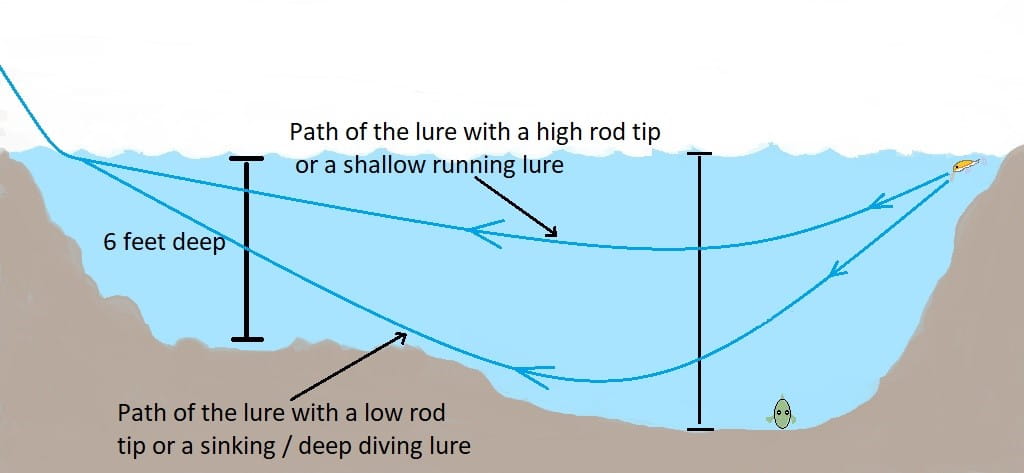
Repeat: Once you have determined the depth that works best, start covering the spot systematically which I discuss below, which basically means start moving your lure to the next spot.
Remember which cast enabled you to either determine where the bottom was or which cast caught you a salmon or got you a bite, so all your consecutive casts after that, you can focus solely on that depth without repeating the three-cast process.
This is the best systematic approach I have found to determine the right depth and for discovering the fish’s location.
Casting Direction for Optimal Results
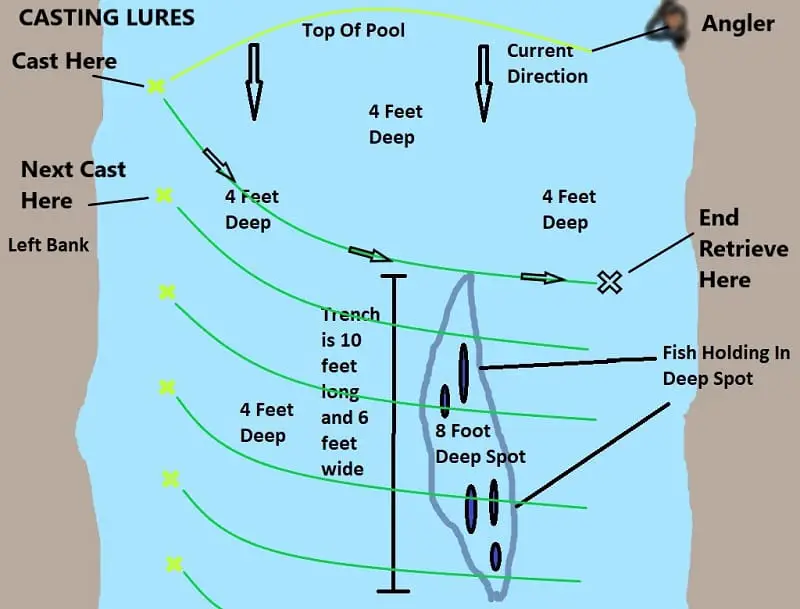
Through my experience, I have found that casting straight across the river or slightly downriver gives me and my clients the best results when using crankbaits.
Although some anglers prefer to cast upriver and retrieve downstream, or cast downstream and reel upriver, I have determined that casting straight across the river is far more effective.
Casting the crankbait sideways, and allowing it to move across the fish’s field of view and showing the lure broadside to the salmon presents an easier and more enticing target.
Effectively Covering the Water
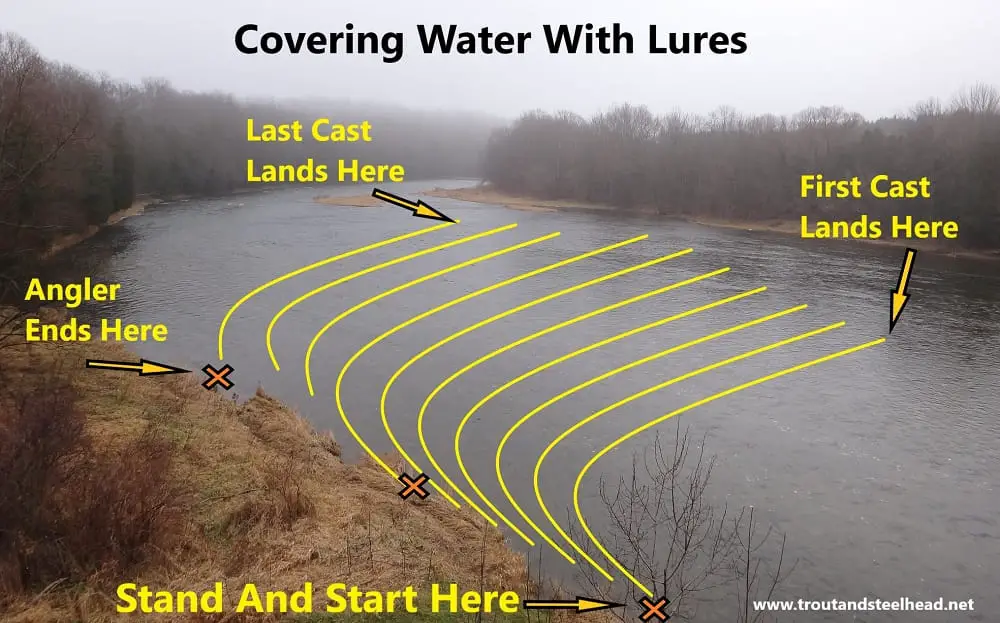
Effective coverage of the water is vital when salmon crankbait fishing. Instead of casting randomly in all directions like many anglers do, it is best to methodically cover the water from top to bottom.
Aimlessly casting is a common issue among anglers which often results in missed fish.
I recommend starting your retrieve at the very top of the fishing spot and gradually moving down 3 to 5 feet with each consecutive cast.
This approach ensures that every salmon in the area has a chance to see and strike at the crankbait, leaving no gaps in coverage. It also ensures that the first time the salmon see the lure, it’s in front of them and not behind them. A lure coming up behind a salmon can spook them since they can not look behind them to see what’s coming
My systematic coverage technique has proven to be 2 to 3 times more effective than aimlessly casting an area.
How River Conditions Effective Crankbait Selection and Fishing Tactics
Having a good understanding of river conditions is essential for adapting your fishing tactics. Factors such as water depth, current speed, water clarity, the presence of structures like rocks and logs, and the width of the river all influence salmon behavior, and you should adjust your lure and your approach appropriately.
Clear Water Fishing With Crankbaits:
In clear water conditions, you can run your crankbait up to 6 feet away from a salmon and potentially trigger a strike response.
I find that silver, gold, and brightly colored crankbaits with reflective surfaces work well in clear water, as they create a visible flash. A slightly faster retrieval speed can also be effective in clear water since salmon can see the lure coming from a greater distance and, therefore they have more time to react.
However, in shallow, clear water, salmon can be easily spooked by the splash of the crankbait, the size, the brightness of the lure, or even its proximity.
To overcome this, consider using smaller and less flashy crankbaits when the salmon are holding and nervous.
For nervous salmon, I cast the crankbait farther away from where the salmon are holding and then retrieve it at a slower pace in front of them to avoid spooking them. Abrupt movements or fast-paced lures can startle salmon, so keeping a natural and subtle presentation at least at first.
If the salmon don’t react to smaller lures or a subtle presentation, add some twitch, jerks, and pause with the smaller lures, and if that doesn’t work try again with different colors, and then with a larger crankbait.
Avoid landing the crankbait directly on top of the salmon or in the middle of the pool, especially on the first few casts.
Instead, I always cast it as close to the far bank as possible and then pull the crankbait in front of and past the salmon. Crankbaits or other lures appearing from behind the fish can also spook them.
Dirty or Stained Water Fishing
When fishing crankbaits in dirtier water or water with reduced visibility, it becomes crucial to get the crankbait closer to the salmon, even within a foot or two if possible.
Slow down your retrieval speed to accommodate the reduced visibility.
The rip, twitch, pause retrieve method is particularly effective in these conditions, but just be sure to allow for longer pauses, which gives salmon the chance to locate and strike at the crankbait even when visibility is poor.
In very muddy water, I recommend using crankbaits with built-in rattles. The added noise helps salmon locate and strike at the lure when they can’t see it very well
When crankbait fishing in dirtier water, I do much better with larger crankbaits and brighter colors, such as five or 6-inch chartreuse crankbaits. Larger and brighter crankbaits provide better visibility and attract attention.
Fast and Slow Water Fishing
When fishing crankbaits for salmon in faster currents, I find that the swing method works best since it allows the lures to move slower and maintain proper action of the lure.
To do this, I simply cast the crankbait across the river and let the current carry it downstream and across the current, adding a few rips and twitches, mimicking the movement of a baitfish.
Avoid reeling too quickly in fast currents, as it can cause the crankbait to pop out of the water or roll, and can also be too fast for the fish to detect and strike.
In slower water, a slow to medium-speed retrieval or a ripping and twitching retrieval is most effective. The swing method is less suitable in these conditions, as a slow current may not provide enough speed to give the lure the proper action and proper depth. Adjust your techniques accordingly to how the crankbait is working.
Understanding and adapting to river conditions is crucial for successful crankbait fishing for salmon. By considering factors such as water clarity, speed, and structure, you can select the most appropriate crankbaits and employ the right tactics to increase your chances of success.
Tight Lines,
Graham

Thank you for this information! It helped me to catch my first King this year on a thunderstick! 38in and 24lbs. I’m definitely hooked on salmon fishing now and really appreciate your content!
Great to hear Kyle, Hopefully the first of many..
Graham